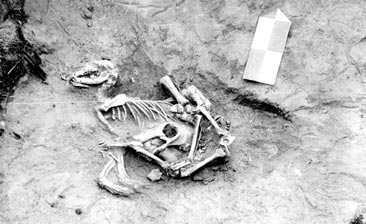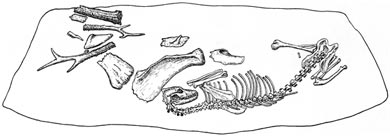New Study Suggests Spiritual Connection between Humans and Dogs in the Neolithic
A study published in the on line academic journal PLoS One (public library of science) looking into the relationship between dog and human burials has revealed some strong links between our species and that of the dog. It seems that dogs had a special place in the working lives of our ancestors and from various grave goods and the symbolic positioning of dogs in burials, they may have had a strong spiritual bond with their human masters.
Strong Human/Dog Relationship
Evidence has emerged over recent years that dogs may have become domesticated as early as 33,00o years ago, to read an article that explores the evidence: Evidence of Dog Domestication from More Than 30,000 Years Ago.
The lead author of the study, University of Alberta (Canada), anthropologist Robert Losey and his team studied a number of ancient burial sites but their research focused on dog burials in the Lake Baikal region of eastern Siberia. One of the objectives of the team was to determine if the practice of dog burial and the inference of a close relationship between these two species correlated with patterns of human subsistence.
One of the Dog Burials Examined in the Study
Picture credit: Journal PLoS One
An Affinity with Dogs
The traditional picture of the dog, or the ancestral dog (a wolf), becoming a partner in the hunt for terrestrial game working alongside humans and sharing the spoils has been challenged as evidence from this region (eastern Siberia) suggests although man and dog had an affinity, large terrestrial mammals such as deer played only a minor role in their diets.
Associate Professor Losey explained:
“If the practice of burying dogs was solely related to their importance in procuring terrestrial game, we would expect to see them in the Early Holocene (around 9,000 years ago), when human subsistence practices were focused on these animals. Further, we would expect to see them in later periods in areas where fish were never really major components of the diet and deer were the primary focus, but they are rare or absent in these regions.”
Dog burials of any kind were the most common during the Early Neolithic (7-8,000 years ago), only foraging groups, the hunter/gatherers seem to have buried dogs. As mankind began to live in settlements and farming communities developed so most cemetery sites that were established are devoid of buried dogs, with the exception of some sacrificed animals.
Dietary Similarities
Both the diets of the people and the dogs seem to have been broadly similar across the regions that were studied. Unsurprisingly, around the Lake Baikal sites most of the protein in both human and dog diets was obtained from fish with some evidence of predation on the local Lake Baikal freshwater seal population.
Evidence from the burials reflect the close association between the human population and the dogs. One dog, for instance was laid to rest as if it were sleeping, whilst another burial site revealed the body of a man who had been buried with two dogs, one either side of his body. Other dog burials show evidence of grave goods, even items that may have been designed with the dog in mind during life.
The research team found evidence of a dog being buried with a round pebble, possibly a favourite toy, carefully placed in its mouth. Other dogs were buried with ornaments and tools such as spoons and stone knives.
An Illustration of a Dog Burial with Other Grave Goods
Picture credit: Journal PLoS One
Associate Professor Losey added:
“I think the hunter-gatherers here saw some of their dogs as being nearly the same as themselves, even at a spiritual level. At this time, dogs were the only animals living closely with humans, and they were likely known at an individual level, far more so than any other animal people encountered. People came to know them as unique, special individuals.”
Relating Research to Modern Perceptions About Dogs
Some of today’s pet owners give their dogs special collars. Others get special items of clothing, not necessarily designed to keep the animal warm but simply to make a fuss of them. People tend to demonstrate anthropomorphism (applying human feelings to animals, treating animals like people). It seems this practice has very ancient roots, as one dog burial revealed a dog had been given a deer-tooth necklace to wear. Deer-toothed necklaces were a common item of jewellery amongst people and it seems that some of these folks liked to dress up their dogs too.
DNA analysis of the dog remains indicate that all the animals in the Lake Baikal burials were similar in size and appearance to the large husky dogs more associated with the far north and sled pull teams of today. From the evidence gathered by the research team, the dog/human bond goes back a long way into human history and as hunter/gatherers we had a very strong bond, perhaps even a spiritual bond with the dog.







Leave A Comment